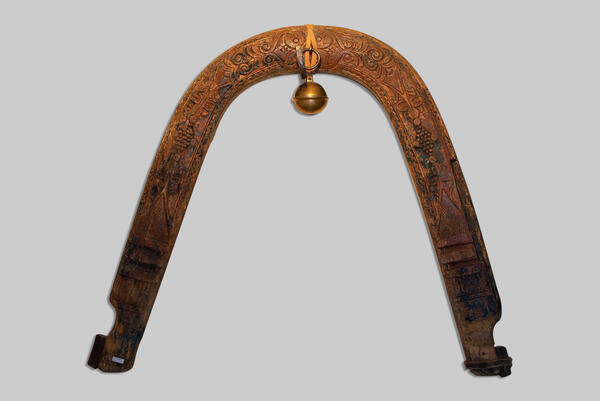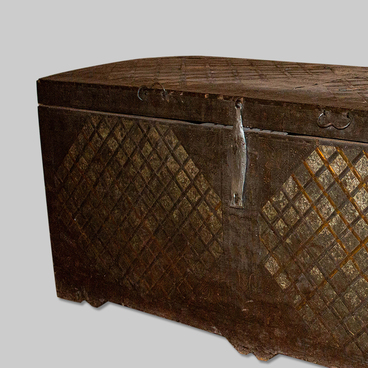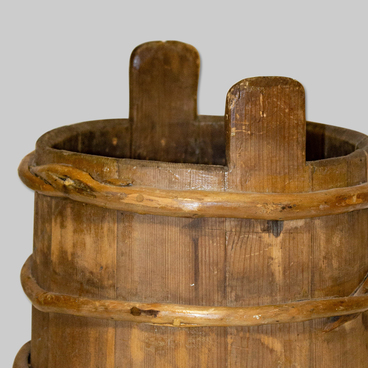A Russian horse harness often had a shaft bow. This device was designed to facilitate the horse’s work. Firstly, the shaft bow made the whole design more rigid. When harnessed like this, the horse did not pull the cart, but pushed it, which helped it move. Secondly, the shaft bow together with other elements of the horse’s harness protected the horse from being hit by a clamp or shaft.
The size of the shaft bow was always customized depending on the size of the animal as well as the weight and dimensions of the carriage. There were one-horse shaft bows as well as shaft bows for troikas, a harness driving combination, using three horses. The shaft bow from the museum collection is intended for one horse. A shaft bow was custom-designed for each horse.
Firm wood, such as elm, oak and hazel, was used for the purpose. The timber had to be prepared early in spring before the trees stored too much sap. The shaft bow-to-be was treated with steam in a sauna or a special steam bath. It was then placed in a special bow machine and bent with the use of horsepower, while wedges were being driven along the bend. The article was then left to dry in a curved position for a few weeks. After that the blank could be processed. The shaft bow had to have slots for shafts. The shaft bow had to be ground. The master then could carve a pattern, like the one on the exhibit, and paint it.
For a long time, the researchers did not consider these decorations to be an important item of national culture. It was not until the 19th century that the interest in shaft bows as a work of art arose. In 1877 researcher Ivan Golyshev included illustrated articles on carved shaft bows in his publication ‘Monuments of ancient Russian wood carving in Vladimir Governorate’. That very same year archaeologist Vladimir Stasov posted an article called ‘The shaft bow and the gingerbread horse’. In the article Stasov poses questions regarding the time when the Russians started using the shaft bow, its decorative features, the symbolic meaning of the ornamentation patterns. He also marks the antiquity of ornamentation motifs of shaft bows and singles out rosettes: solar symbols, shamrocks, grapevines, the image of the earth in the shape of a triangular slide.
The size of the shaft bow was always customized depending on the size of the animal as well as the weight and dimensions of the carriage. There were one-horse shaft bows as well as shaft bows for troikas, a harness driving combination, using three horses. The shaft bow from the museum collection is intended for one horse. A shaft bow was custom-designed for each horse.
Firm wood, such as elm, oak and hazel, was used for the purpose. The timber had to be prepared early in spring before the trees stored too much sap. The shaft bow-to-be was treated with steam in a sauna or a special steam bath. It was then placed in a special bow machine and bent with the use of horsepower, while wedges were being driven along the bend. The article was then left to dry in a curved position for a few weeks. After that the blank could be processed. The shaft bow had to have slots for shafts. The shaft bow had to be ground. The master then could carve a pattern, like the one on the exhibit, and paint it.
For a long time, the researchers did not consider these decorations to be an important item of national culture. It was not until the 19th century that the interest in shaft bows as a work of art arose. In 1877 researcher Ivan Golyshev included illustrated articles on carved shaft bows in his publication ‘Monuments of ancient Russian wood carving in Vladimir Governorate’. That very same year archaeologist Vladimir Stasov posted an article called ‘The shaft bow and the gingerbread horse’. In the article Stasov poses questions regarding the time when the Russians started using the shaft bow, its decorative features, the symbolic meaning of the ornamentation patterns. He also marks the antiquity of ornamentation motifs of shaft bows and singles out rosettes: solar symbols, shamrocks, grapevines, the image of the earth in the shape of a triangular slide.



